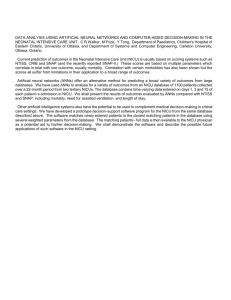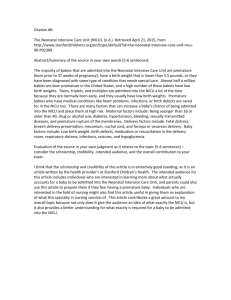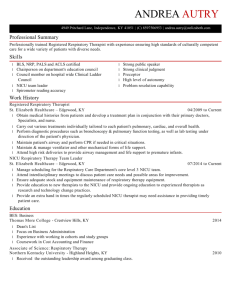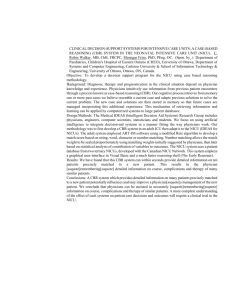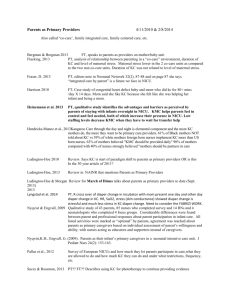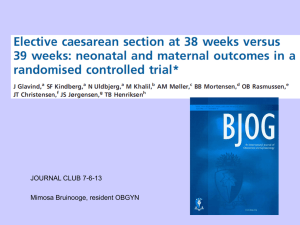Rich History in Neonatal Care Written By: Charles Rosenfeld, M.D.
advertisement
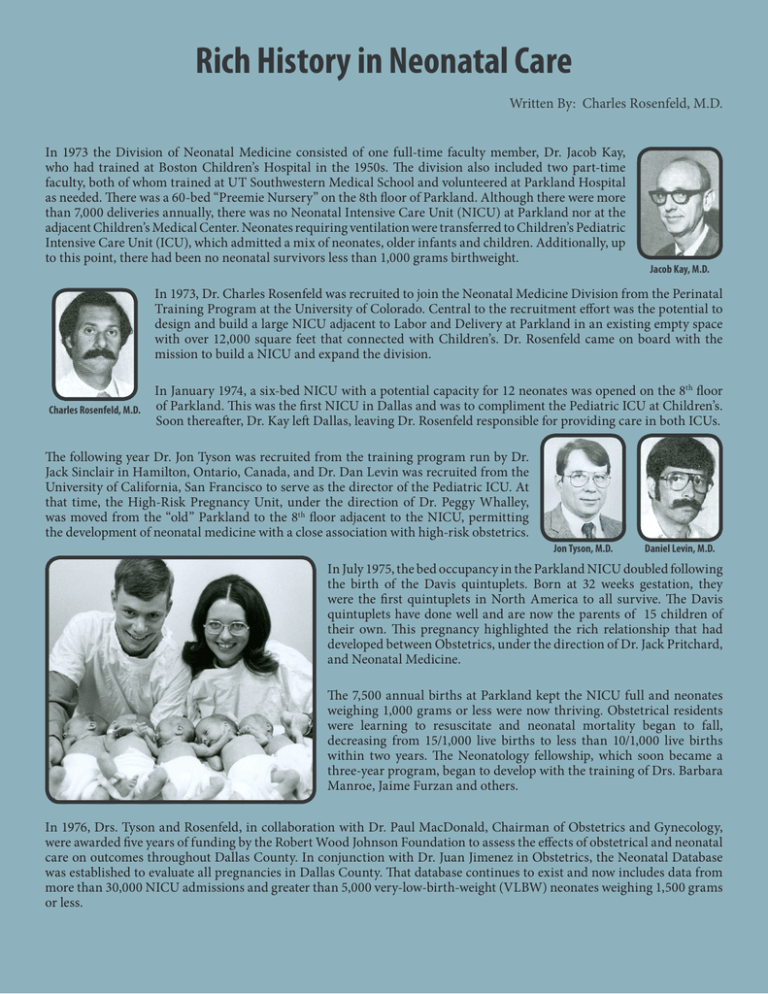
Rich History in Neonatal Care Written By: Charles Rosenfeld, M.D. In 1973 the Division of Neonatal Medicine consisted of one full-time faculty member, Dr. Jacob Kay, who had trained at Boston Children’s Hospital in the 1950s. The division also included two part-time faculty, both of whom trained at UT Southwestern Medical School and volunteered at Parkland Hospital as needed. There was a 60-bed “Preemie Nursery” on the 8th floor of Parkland. Although there were more than 7,000 deliveries annually, there was no Neonatal Intensive Care Unit (NICU) at Parkland nor at the adjacent Children’s Medical Center. Neonates requiring ventilation were transferred to Children’s Pediatric Intensive Care Unit (ICU), which admitted a mix of neonates, older infants and children. Additionally, up to this point, there had been no neonatal survivors less than 1,000 grams birthweight. Jacob Kay, M.D. In 1973, Dr. Charles Rosenfeld was recruited to join the Neonatal Medicine Division from the Perinatal Training Program at the University of Colorado. Central to the recruitment effort was the potential to design and build a large NICU adjacent to Labor and Delivery at Parkland in an existing empty space with over 12,000 square feet that connected with Children’s. Dr. Rosenfeld came on board with the mission to build a NICU and expand the division. Charles Rosenfeld, M.D. In January 1974, a six-bed NICU with a potential capacity for 12 neonates was opened on the 8th floor of Parkland. This was the first NICU in Dallas and was to compliment the Pediatric ICU at Children’s. Soon thereafter, Dr. Kay left Dallas, leaving Dr. Rosenfeld responsible for providing care in both ICUs. The following year Dr. Jon Tyson was recruited from the training program run by Dr. Jack Sinclair in Hamilton, Ontario, Canada, and Dr. Dan Levin was recruited from the University of California, San Francisco to serve as the director of the Pediatric ICU. At that time, the High-Risk Pregnancy Unit, under the direction of Dr. Peggy Whalley, was moved from the “old” Parkland to the 8th floor adjacent to the NICU, permitting the development of neonatal medicine with a close association with high-risk obstetrics. Jon Tyson, M.D. Daniel Levin, M.D. In July 1975, the bed occupancy in the Parkland NICU doubled following the birth of the Davis quintuplets. Born at 32 weeks gestation, they were the first quintuplets in North America to all survive. The Davis quintuplets have done well and are now the parents of 15 children of their own. This pregnancy highlighted the rich relationship that had developed between Obstetrics, under the direction of Dr. Jack Pritchard, and Neonatal Medicine. The 7,500 annual births at Parkland kept the NICU full and neonates weighing 1,000 grams or less were now thriving. Obstetrical residents were learning to resuscitate and neonatal mortality began to fall, decreasing from 15/1,000 live births to less than 10/1,000 live births within two years. The Neonatology fellowship, which soon became a three-year program, began to develop with the training of Drs. Barbara Manroe, Jaime Furzan and others. In 1976, Drs. Tyson and Rosenfeld, in collaboration with Dr. Paul MacDonald, Chairman of Obstetrics and Gynecology, were awarded five years of funding by the Robert Wood Johnson Foundation to assess the effects of obstetrical and neonatal care on outcomes throughout Dallas County. In conjunction with Dr. Juan Jimenez in Obstetrics, the Neonatal Database was established to evaluate all pregnancies in Dallas County. That database continues to exist and now includes data from more than 30,000 NICU admissions and greater than 5,000 very-low-birth-weight (VLBW) neonates weighing 1,500 grams or less. Additional faculty were soon recruited from prestigious institutions, including Dr. Bill Engle from Children’s Hospital of Philadelpia in 1980, Dr. Abbot Laptook from Brown University in 1981 and Dr. Heber Nielsen from Harvard, also in 1981. The division’s research base expanded to include studies of cerebral blood flow and metabolism, renal physiology and surfactant synthesis. The division also was asked to collaborate in the first large scale assessment of bronchopulmonar dysplasia (BPD) by the National Institutes of Health (NIH). Bill Engle, M.D. Abbot Laptook, M.D. Heber Nielsen, M.D. With the Parkland NICU now at full capacity and no NICU at Children’s, there was an increasing lack of bed space. The Pediatric Burn Unit was moved from the 8th floor at Parkland, creating room for the expanded intensive care area of the NICU with 15 beds. The older NICU area became the step-down or intermediate care area. This resulted in 27 ICU beds to cover the more than 8,000 births and approximately 1,000 NICU admissions occurring annually. The Hospital District and County Commissioners soon realized that Parkland needed to be updated and the NICU needed to expand and move to the space adjacent to Labor and Delivery. In 1980, with the efforts of Ralph Rogers, Chairman of the Hospital Board, and many others, an $80 million bond issue was passed by the people of Dallas to modernize Parkland and build a new NICU. When the new NICU opened in 1984, neonates were successfully transported down five floors to a large, modern NICU located less than 50 feet from Labor and Delivery. The new NICU was eqipped with 15-20 ICU beds and 40 ACN/CCN beds to accommodate the increase in deliveries to 11,000 annually. From 1985 to 1988 the division welcomed eight new faculty members from academic institutions across the nation. Included in the new faculty was a developmental psychologist, Dr. Bob Lasky, who was recruited to run the Low Birth Weight Followup Clinic, to initiate research in auditory evoke potentials, and to permit the division to collaborate successfully with Dr. Marie McCormic at Harvard on a nationwide study of early intervetion in VLBW neonates. The fellowship Program grew to two to three trainees each year, and the teaching and research efforts of the division were thriving in the 1980s. Through the efforts of Dr. Jon Tyson, the division was selected as a founding institution in the development of the NIH-sponsored Neonatal Network for Clinical Trials in 1986. It has since remained an important player in the network, reflecting successful efforts to recruit patients and by maintaining an outstanding follow-up program run by Dr. Sue Broyles from 1991 through 2002 and Dr. Roy Heyne since 2003. The follow-up program was nationally recongized as the first randomized controlled trial to report that primary care offered a significant advantage to the outcome of VLBW neonates. In the 1990s, the NICU at Parkland was chosen by the Hospital Administration as one of seven Centers of Excellence. The clinical, research and teaching programs were further strengthened with the recruitment of Dr. Jeff Perlman from Washington University, Dr. Fernando Moya from Yale, Dr. Philip Shaul from Brown and Drs. Pablo Sanchez, Blair Cox, Myra Wyckoff and Walid Salhab from UT Southwestern between 1990 and 2000. Sue Broyles, M.D. Roy Heyne, M.D. Dr. Greg Jackson was recruited in 1989 to direct the division’s teaching and clinical program in the term nursery and to develop the Pediatric Nurse Practitioner Program and was joined by Dr. Dorothy Sendelbach in 1993. At present there are seven general pediatricians in the division who teach, do clinical research and both supervise and provide care to nearly 15,000 near-term and term neonates annually. This group has added to the scholarly activities of the division and has excelled in teaching. Jeffrey Perlman, M.D. Philip Shaul, M.D. Pablo Sanchez, M.D. Blair Cox, M.D. Myra Wyckoff, M.D. Walid Salhab, M.D. Greg Jackson, M.D. Dorothy Sendelbach, M.D. In 1981, the Obstetrics and Pediatric staff at St. Paul Hospital approached the division to consider starting a NICU and assuming care of their high-risk patients. This provided an opportunity to develop a referral program for women with high-risk pregnancies and neonates on the campus and to incorporate the clinical expertise available at St. Paul to deliver c to these patients. An educational outreach program was developed expanding the referral base for neonates and at-risk pregnant women to include areas of north and east Texas. Dr. Jon Tyson was the first Medical Director of the outreach program and was succeeded by Dr. Kathleen Kennedy. St. Paul served as an excellent training experience for the pediatric residents until Texas Health Resources purchased the it in 2000. Although the new Parkland NICU was designed to accommodate neonates from approximately 12,000 deliveries annually, it has since required renovation and expansion to address the continuing increase in deliveries. There are presently more than 15,000 births per year and approximately 1,300 admissions to the Level III NICU, making it one of the busiest in the nation. Efforts began in 2000 to establish a referral NICU at Children’s, and in April 2007 a temporary 16-bed NICU was opened. In 2009, a permanent expansion to a 36-bed referral NICU occurred, allowing the Children’s NICU to become a major site for neonatal referrals in the area. Recruitment efforts continue in order to provide excellence in research, training, clinical care and long-term follow-up for high-risk pregnant women and neonates in North Texas. Dr. Rashmin Savani joined the division in March 2006 and became the Division Director when Dr. Rosenfeld stepped down in January 2007. During Dr. Rosenfeld’s 34 years as Director there were more than 250,000 births and Charles R. Rosenfeld, M.D. nearly 30,000 NICU admissions at Parkland. The fellowship program, now under the direction of Dr. Luc Brion, has trained at least 60 fellows in Neonatal-Perinatal Medicine, many of whom have pursued academic careers. Rashmin Savani, M.B.Ch.B. In 2010 the division totaled 24 faculty and 12 fellows. Several faculty members have moved to become Directors of other divisions or successful investigators at their respective institutions. All of this exemplifies the extra ordinary group of faculty assembled by the division over time, their collaborative nature and their continued commitment to excellence.
